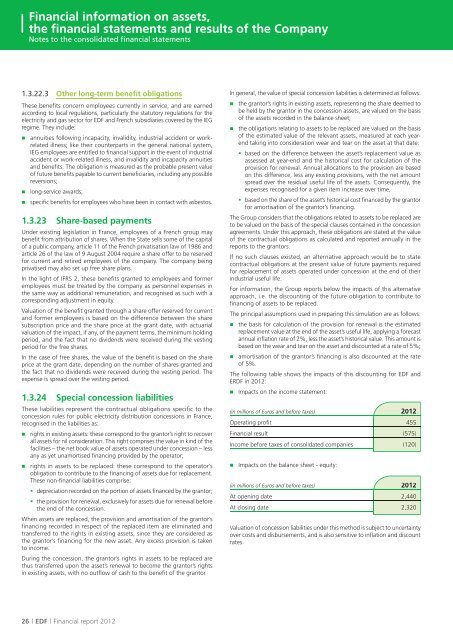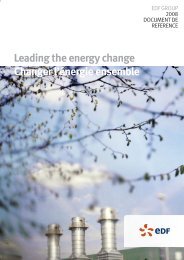PDF, 1.6 Mb - Shareholders and investors - EDF
PDF, 1.6 Mb - Shareholders and investors - EDF
PDF, 1.6 Mb - Shareholders and investors - EDF
You also want an ePaper? Increase the reach of your titles
YUMPU automatically turns print PDFs into web optimized ePapers that Google loves.
Financial information on assets,the financial statements <strong>and</strong> results of the CompanyNotes to the consolidated financial statements1.3.22.3 Other long-term benefit obligationsThese benefits concern employees currently in service, <strong>and</strong> are earnedaccording to local regulations, particularly the statutory regulations for theelectricity <strong>and</strong> gas sector for <strong>EDF</strong> <strong>and</strong> French subsidiaries covered by the IEGregime. They include:• annuities following incapacity, invalidity, industrial accident or workrelatedillness; like their counterparts in the general national system,IEG employees are entitled to financial support in the event of industrialaccident or work-related illness, <strong>and</strong> invalidity <strong>and</strong> incapacity annuities<strong>and</strong> benefits. The obligation is measured as the probable present valueof future benefits payable to current beneficiaries, including any possiblereversions;• long-service awards;• specific benefits for employees who have been in contact with asbestos.1.3.23 Share-based paymentsUnder existing legislation in France, employees of a French group maybenefit from attribution of shares. When the State sells some of the capitalof a public company, article 11 of the French privatisation law of 1986 <strong>and</strong>article 26 of the law of 9 August 2004 require a share offer to be reservedfor current <strong>and</strong> retired employees of the company. The company beingprivatised may also set up free share plans.In the light of IFRS 2, these benefits granted to employees <strong>and</strong> formeremployees must be treated by the company as personnel expenses inthe same way as additional remuneration, <strong>and</strong> recognised as such with acorresponding adjustment in equity.Valuation of the benefit granted through a share offer reserved for current<strong>and</strong> former employees is based on the difference between the sharesubscription price <strong>and</strong> the share price at the grant date, with actuarialvaluation of the impact, if any, of the payment terms, the minimum holdingperiod, <strong>and</strong> the fact that no dividends were received during the vestingperiod for the free shares.In the case of free shares, the value of the benefit is based on the shareprice at the grant date, depending on the number of shares granted <strong>and</strong>the fact that no dividends were received during the vesting period. Theexpense is spread over the vesting period.1.3.24 Special concession liabilitiesThese liabilities represent the contractual obligations specific to theconcession rules for public electricity distribution concessions in France,recognised in the liabilities as:• rights in existing assets: these correspond to the grantor’s right to recoverall assets for nil consideration. This right comprises the value in kind of thefacilities – the net book value of assets operated under concession – lessany as yet unamortised financing provided by the operator;• rights in assets to be replaced: these correspond to the operator’sobligation to contribute to the financing of assets due for replacement.These non-financial liabilities comprise:• depreciation recorded on the portion of assets financed by the grantor;• the provision for renewal, exclusively for assets due for renewal beforethe end of the concession.When assets are replaced, the provision <strong>and</strong> amortisation of the grantor’sfinancing recorded in respect of the replaced item are eliminated <strong>and</strong>transferred to the rights in existing assets, since they are considered asthe grantor’s financing for the new asset. Any excess provision is takento income.During the concession, the grantor’s rights in assets to be replaced arethus transferred upon the asset’s renewal to become the grantor’s rightsin existing assets, with no outflow of cash to the benefit of the grantor.In general, the value of special concession liabilities is determined as follows:• the grantor’s rights in existing assets, representing the share deemed tobe held by the grantor in the concession assets, are valued on the basisof the assets recorded in the balance sheet;• the obligations relating to assets to be replaced are valued on the basisof the estimated value of the relevant assets, measured at each yearendtaking into consideration wear <strong>and</strong> tear on the asset at that date:• based on the difference between the asset’s replacement value asassessed at year-end <strong>and</strong> the historical cost for calculation of theprovision for renewal. Annual allocations to the provision are basedon this difference, less any existing provisions, with the net amountspread over the residual useful life of the assets. Consequently, theexpenses recognised for a given item increase over time,• based on the share of the asset’s historical cost financed by the grantorfor amortisation of the grantor’s financing.The Group considers that the obligations related to assets to be replaced areto be valued on the basis of the special clauses contained in the concessionagreements. Under this approach, these obligations are stated at the valueof the contractual obligations as calculated <strong>and</strong> reported annually in thereports to the grantors.If no such clauses existed, an alternative approach would be to statecontractual obligations at the present value of future payments requiredfor replacement of assets operated under concession at the end of theirindustrial useful life.For information, the Group reports below the impacts of this alternativeapproach, i.e. the discounting of the future obligation to contribute tofinancing of assets to be replaced.The principal assumptions used in preparing this simulation are as follows:• the basis for calculation of the provision for renewal is the estimatedreplacement value at the end of the asset’s useful life, applying a forecastannual inflation rate of 2%, less the asset’s historical value. This amount isbased on the wear <strong>and</strong> tear on the asset <strong>and</strong> discounted at a rate of 5%;• amortisation of the grantor’s financing is also discounted at the rateof 5%.The following table shows the impacts of this discounting for <strong>EDF</strong> <strong>and</strong>ERDF in 2012:• Impacts on the income statement:(in millions of Euros <strong>and</strong> before taxes) 2012Operating profit 455Financial result (575)Income before taxes of consolidated companies (120)• Impacts on the balance sheet - equity:(in millions of Euros <strong>and</strong> before taxes) 2012At opening date 2,440At closing date 2,320Valuation of concession liabilities under this method is subject to uncertaintyover costs <strong>and</strong> disbursements, <strong>and</strong> is also sensitive to inflation <strong>and</strong> discountrates.26 l <strong>EDF</strong> l Financial report 2012











